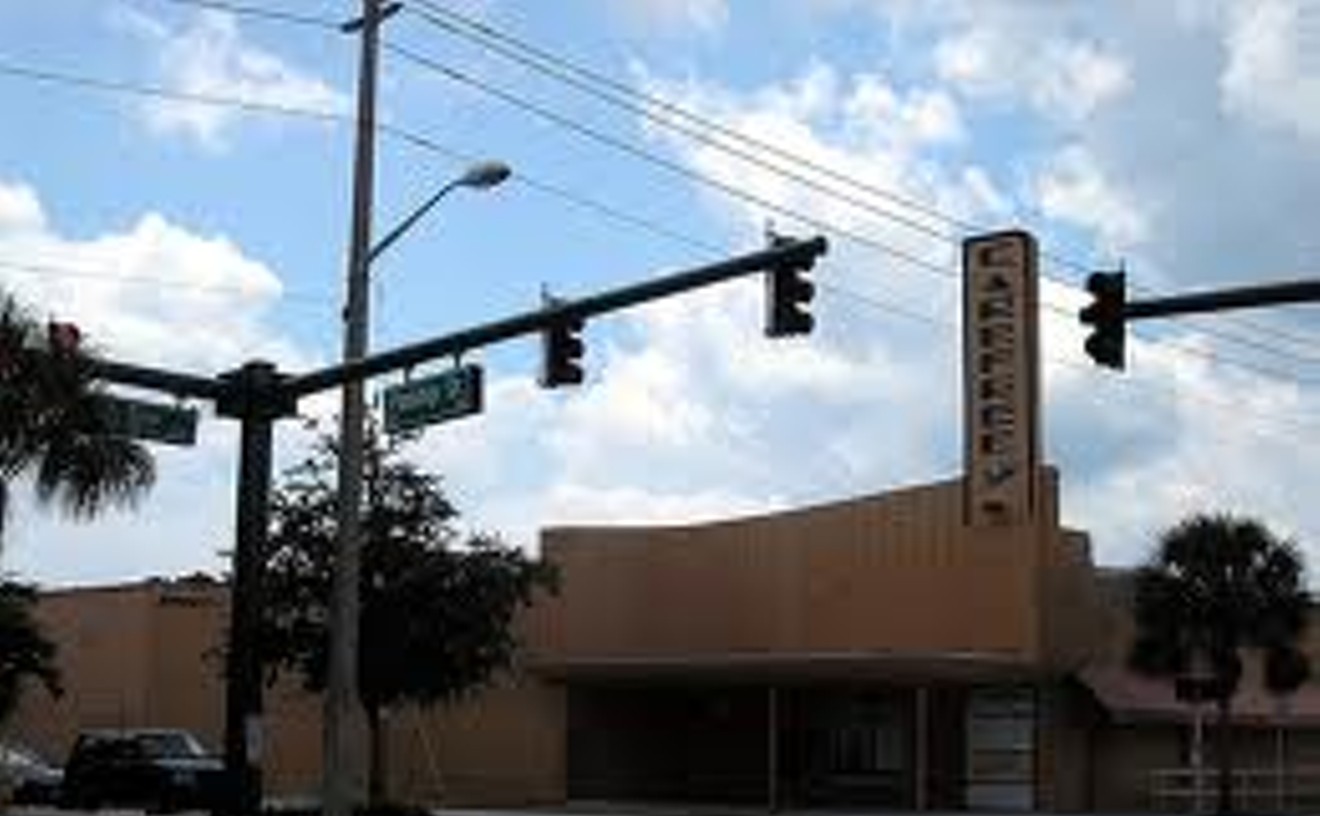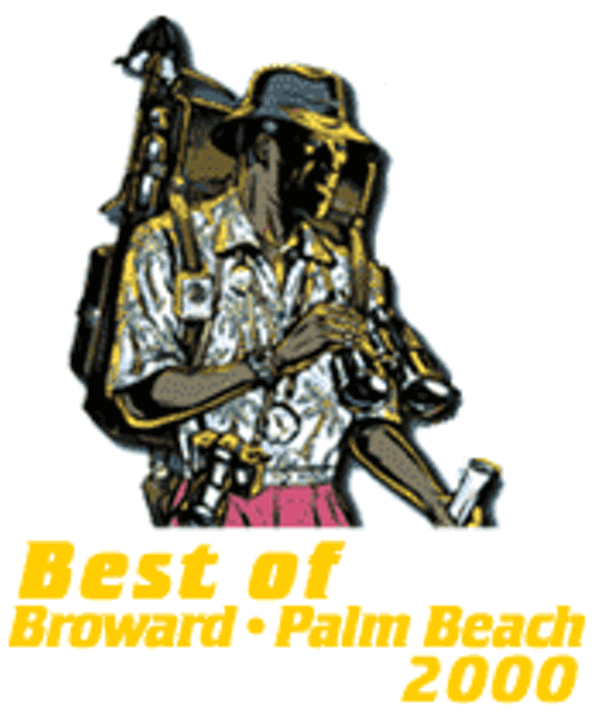Best Production of a Play
Quills
In many American political plays, a guy (it's usually a guy) comes on stage and talks. The set, the costumes, the lighting -- they're all window-dressing, which helps to explain the sorry state of political drama. Doug Wright's 1995 work Quills, however, dissects the issues of censorship through the trials of the Marquis de Sade. It's a play of ideas, driving home the notion that you can't get rid of art you don't like merely by destroying its author. But it's also a play of images. In the exquisitely designed Florida Stage production, Jim Fulton's lighting design reproduced the Marquis' naughty writing as luminescent streaks across the theater walls. Allen D. Cornell's inventive turntable set gave rise to multiple arresting scenes -- not the least of which was the yanking out of the Marquis' tongue. Suzette Pare's costumes smartly outfitted the small-minded denizens of 19th-century France as well as the increasingly-more-disrobed Marquis. And Scott Burgess' sound design created an asylumwide orgy we could "see" though it happened off stage. At the helm was artistic director Louis Tyrrell, whose fluid hand and wicked sense of humor proved to be assets the Marquis would have loved.
Best Movie Theater
Carefree Theatre

The Carefree Theatre is about as ugly as you can get in a movie theater: The seats are bereft of stuffing, the one screen is annoyingly old school, and the floor is, well, let's just say you wouldn't want to sit on it. But in a place about as arty as a late-night B-movie Baywatch rip-off, we're willing to forgive the lack of pretentiousness. Besides, we've caught some great oddball flicks at the Carefree in the last year: Boys Don't Cry (before it became a multiplex sensation after Hillary Swank took home an Oscar), Twin Falls Idaho, and Eric Rohmer's Conte d'Automne (that's Autumn Tale for you non-art-moviegoers), to name just a few. Not to mention the irreverent, occasionally brilliant, one-night-only FLO Film Festival, which featured a hilarious short film about a dude having his girlfriend's name tattooed on his penis. (See if you can find that at your local gigabyteplex.) Oh yeah. The Carefree also does The Rocky Horror Picture Show every Saturday at midnight. That is so, um, arty.
- 2000 S. Dixie Highway, West Palm Beach, 33401 Map
- 561-833-7305
Best Movie Theater
Carefree Theatre
The Carefree Theatre is about as ugly as you can get in a movie theater: The seats are bereft of stuffing, the one screen is annoyingly old school, and the floor is, well, let's just say you wouldn't want to sit on it. But in a place about as arty as a late-night B-movie Baywatch rip-off, we're willing to forgive the lack of pretentiousness. Besides, we've caught some great oddball flicks at the Carefree in the last year: Boys Don't Cry (before it became a multiplex sensation after Hillary Swank took home an Oscar), Twin Falls Idaho, and Eric Rohmer's Conte d'Automne (that's Autumn Tale for you non-art-moviegoers), to name just a few. Not to mention the irreverent, occasionally brilliant, one-night-only FLO Film Festival, which featured a hilarious short film about a dude having his girlfriend's name tattooed on his penis. (See if you can find that at your local gigabyteplex.) Oh yeah. The Carefree also does The Rocky Horror Picture Show every Saturday at midnight. That is so, um, arty.
Best Free Thrill
Locations along Perimeter Road
Aviation has been around for oh, 80 some years, but the sight of flying machines still inspires awe in people. That's why dozens of aeronautics enthusiasts can be seen, practically any time of the day or night, parked at two locations on the fringes of Fort Lauderdale's major airport to watch the planes take off and land. These are serious plane watchers, armed with ladders for better vantage points, binoculars, cameras, and even books that picture the various aircraft types. Like bird watching, plane watching is a spectator sport around the world but is becoming restricted by security-conscious airports. Enthusiasts rate the Broward experience as superior. (Their criteria: closeness to the runway and good weather.) There are two spots offering parking: One offers good views of small aircraft taking off on their runway (alas, no jets) but does provide park benches and shade; the other, more popular area, near Broward County Animal Care and Control, is closer -- only 50 feet or so from the planes. Take Griffin Road just west of Federal Highway to Perimeter Road.
Best Free Thrill
Locations along Perimeter Road
Aviation has been around for oh, 80 some years, but the sight of flying machines still inspires awe in people. That's why dozens of aeronautics enthusiasts can be seen, practically any time of the day or night, parked at two locations on the fringes of Fort Lauderdale's major airport to watch the planes take off and land. These are serious plane watchers, armed with ladders for better vantage points, binoculars, cameras, and even books that picture the various aircraft types. Like bird watching, plane watching is a spectator sport around the world but is becoming restricted by security-conscious airports. Enthusiasts rate the Broward experience as superior. (Their criteria: closeness to the runway and good weather.) There are two spots offering parking: One offers good views of small aircraft taking off on their runway (alas, no jets) but does provide park benches and shade; the other, more popular area, near Broward County Animal Care and Control, is closer -- only 50 feet or so from the planes. Take Griffin Road just west of Federal Highway to Perimeter Road.
Best Ensemble Cast
How I Learned to Drive
Paula Vogel's 1998 Pulitzer Prize winner How I Learned to Drive is not an easy play to sit through. Incest, alcoholism, self-destruction, and probing questions about the nature of love are the subjects it takes on. Told through the eyes of Li'l Bit, a woman who looks back at her youth and girlhood to recount how she was molested by a favorite uncle, the drama requires actors to portray two fully fleshed people (Li'l Bit and Uncle Peck), as well as a Greek chorus of family members and secondary characters. The excellent Caldwell Theatre Company cast featured Kim Cozort and David Forsyth as the protagonists, both of whom gave subtly multifaceted and complex performances. Supporting them, and acting with much broader strokes, were the magnificent Dan Leonard, Jessica K. Peterson, and Viki Boyle. Director Kenneth Kay couldn't have asked for more happy chemistry or more galvanic talent. And neither could we.
Best Ensemble Cast
How I Learned to Drive
Paula Vogel's 1998 Pulitzer Prize winner How I Learned to Drive is not an easy play to sit through. Incest, alcoholism, self-destruction, and probing questions about the nature of love are the subjects it takes on. Told through the eyes of Li'l Bit, a woman who looks back at her youth and girlhood to recount how she was molested by a favorite uncle, the drama requires actors to portray two fully fleshed people (Li'l Bit and Uncle Peck), as well as a Greek chorus of family members and secondary characters. The excellent Caldwell Theatre Company cast featured Kim Cozort and David Forsyth as the protagonists, both of whom gave subtly multifaceted and complex performances. Supporting them, and acting with much broader strokes, were the magnificent Dan Leonard, Jessica K. Peterson, and Viki Boyle. Director Kenneth Kay couldn't have asked for more happy chemistry or more galvanic talent. And neither could we.
Best Gay Bar
Cathode Ray Club
Cathode Ray is more than a bar: It's three distinct places to hang beneath one television-strung roof. Take a left past the giant saltwater aquarium by the front door and you'll enter a plush foyer bar complete with wing chairs, honey-color wooden floors, and a pristine white piano. Feel like playing around? The back bar gives clientele a chance to do just that. Cutouts of football players grace a side wall, and electronic dart boards, a pool table, and retro video games like Centipede and Ms. Pac-Man add to the frat-boy ambiance. If you're more interested in a little bump and grind, a final back bar borders a dance floor where you can hear house and other electronica till 2 a.m. No matter where you are, the bar's namesake looms large: Every few feet there's a monitor flashing selections from a library of more than 50,000 hours of video, and virtually all of it features one or more luscious hotties playing pool, fixing cars, or engaged in some similarly manly act. With a kitchen serving seared-tuna nachos, weeknights devoted to Ally McBeal and Will & Grace, and a host of buff babes sidling up to the bar at any given hour, why would you want to go anywhere else?
Best Gay Bar
Cathode Ray Club
Cathode Ray is more than a bar: It's three distinct places to hang beneath one television-strung roof. Take a left past the giant saltwater aquarium by the front door and you'll enter a plush foyer bar complete with wing chairs, honey-color wooden floors, and a pristine white piano. Feel like playing around? The back bar gives clientele a chance to do just that. Cutouts of football players grace a side wall, and electronic dart boards, a pool table, and retro video games like Centipede and Ms. Pac-Man add to the frat-boy ambiance. If you're more interested in a little bump and grind, a final back bar borders a dance floor where you can hear house and other electronica till 2 a.m. No matter where you are, the bar's namesake looms large: Every few feet there's a monitor flashing selections from a library of more than 50,000 hours of video, and virtually all of it features one or more luscious hotties playing pool, fixing cars, or engaged in some similarly manly act. With a kitchen serving seared-tuna nachos, weeknights devoted to Ally McBeal and Will & Grace, and a host of buff babes sidling up to the bar at any given hour, why would you want to go anywhere else?
Best Blues Band
Nucklebusters Blues Band
Over the course of its 13-year run on the South Florida club circuit, the Nucklebusters Blues Band has served as the house band at a number of reputable local venues, including the legendary Musician's Exchange in Fort Lauderdale. Having suffered innumerable lineup changes over the years, the Nucklebusters are still riding high in the saddle with a current roster consisting of mainstay vocalist and lead guitarist "Famous" Frank Ward, vocalist-bassist Sheldon Voss, vocalist- harmonica player Jason Ricci, drummer Tim Kuchta, and organist Joe Saint. The band's specialty is raucous, Chicago-style blues, and after all their years of nonstop gigging, Famous Frank and the boys pretty much have their act down cold. With a vast repertoire of tunes, including everything from original roadhouse boogie and smoldering instrumentals to swingin' covers of Howlin' Wolf's "Killing Floor" and Big Bill Broonzy's "I Feel So Good," it's not surprising that when locals want their blues kicks, they go looking for Nucklebusters.





